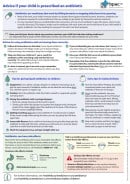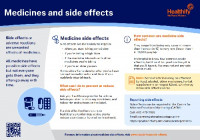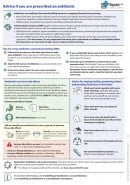Wishing everyone happy holidays and a joyful New Year from the Healthify team. Don't forget to Slip, Slop, Slap and Wrap!
Amoxicillin + clavulanic acid
Also called Augmentin, Amoxiclav, Curam and Curam Duo
Key points about amoxicillin + clavulanic acid
- Amoxicillin + clavulanic acid is an antibiotic used to treat infections caused by bacteria.
- It belongs to a group of antibiotics called penicillins. Don’t take this medicine if you're allergic to penicillin antibiotics.
- Amoxicillin + clavulanic acid is also called Augmentin®, Amoxiclav®, Curam® or Curam Duo®.

Amoxicillin + clavulanic acid contains 2 medicines in 1 tablet and is an antibiotic used to treat different infections caused by bacteria, such as sinus infections, urine infections, skin infections, joint infections and some dental infections.
It works by killing or stopping the growth of bacteria (bugs) and gets rid of the infection. Like all antibiotics, it's not effective against infections caused by viruses.
Allergy to penicillin
-
Before taking amoxicillin +clavulanic acid: Tell your healthcare provider if you have had an allergic reaction to a medicine, especially a penicillin antibiotic. True penicillin allergy is rare – fewer than 5 out of 10,000 people are allergic to penicillin. Most people who think they have a penicillin allergy do not – read more about penicillins and penicillin allergy.
-
After taking amoxicillin + clavulanic acid: If you develop signs of an allergic reaction such as skin rash, itching, swelling of your lips, face and mouth, or difficulty breathing, stop taking amoxicillin + clavulanic acid and seek immediate medical attention.
In Aotearoa New Zealand, amoxicillin + clavulanic acid is available as tablets (625 mg), 2 strengths of liquid suspension, and can be given as an injection in the hospital.
- Always take your medicine exactly as your doctor has told you. The pharmacy label on your medicine will tell you how much to take, how often to take it and any special instructions.
- The dose of amoxicillin + clavulanic acid will be different for different people depending on the type of infection and your age.
- The usual dose in adults is 1 tablet 3 times a day.
- The dose for children will depend on their body weight. It's usually given 3 times a day.
- Your healthcare provider will advise you how long to take amoxicillin + clavulanic acid for (usually 3 to 10 days).
- Tablets: Swallow the tablets whole with a glass of water.
- Liquid: Shake the bottle well and measure the dose with an oral syringe or measuring spoon.
- Timing of your doses: Take amoxicillin + clavulanic acid with or after food. This helps to prevent stomach upset. Amoxicillin + clavulanic acid is usually given 3 times a day. Try to space the doses evenly throughout the day, such as first thing in the morning, early afternoon and at bedtime.
- Missed dose: If you forget to take your dose, take it as soon as you remember. But if it's nearly time for your next dose, take the next dose at the right time. Don't take extra doses to make up for a forgotten dose. If you're not sure what to do, ask your healthcare provider.
- Finish the course: Take the whole course of antibiotics for the number of days your doctor has told you to. Don't stop taking it, even if you feel your infection has cleared up. If you stop your treatment early, your infection could come back.
Here are some things to know when you're taking amoxicillin + clavulanic acid. Other things may be important as well, so ask your healthcare provider what you should know about.
- Alcohol: It’s generally a good idea to avoid alcohol when your body is dealing with an infection but alcohol doesn’t interfere with how amoxicillin + clavulanic acid works. This means that most people could have the occasional drink while taking it without any serious problems. However, if amoxicillin + clavulanic acid makes you feel sick (nausea), don’t drink alcohol as it will make you feel worse.
- Oral contraceptives: You don’t need to take any extra precautions while you’re taking amoxicillin + clavulanic acid because it doesn’t affect your oral contraceptive. But if the antibiotics or the illness they're treating cause diarrhoea (runny poo) or vomiting (being sick) lasting more than 24 hours, absorption of the contraceptive pill may be affected. If this happens, ask your healthcare provider for advice about what is needed to prevent a pregnancy.
- Other medicines: Amoxicillin + clavulanic acid interacts with some medicines, herbal supplements and rongoā Māori, so check with your doctor or pharmacist before starting this antibiotic.
- Storage of the liquid: Amoxicillin + clavulanic acid liquid should be stored in the fridge and only lasts 7 days. If your child has been prescribed treatment for more than 7 days you’ll need to collect a repeat of this medicine from your pharmacy.
Like all medicines amoxicillin + clavulanic acid can cause side effects, although not everyone gets them. If you're concerned about any symptoms you think might be related to your medicine, talk to your healthcare provider. The following information offers some guidance but doesn't include all possible side effects.
Common side effects
Tell your healthcare provider if these side effects bother you.
- Nausea (feeling sick) or vomiting (being sick). Try taking your medicine with food. If you vomit within in 30 minutes of taking amoxicillin + clavulanic acid, take the same dose again. But if you vomit more than 30 minutes afterwards, you don't need to take another dose. Wait until the next normal dose. If you're also taking the oral contraceptive pill let your healthcare provider or pharmacist know.
- Diarrhoea (loose, watery stools/poo). Drink plenty of fluids such as water to avoid dehydration. Tell your doctor if it becomes severe or contains blood. If you’re also taking the oral contraceptive pill, let your healthcare provider or pharmacist know.
- Teeth staining from liquid amoxicillin + clavulanic acid. This doesn't last and can be removed by brushing your teeth.
Ask your healthcare provider or pharmacist for advice or phone Healthline free on 0800 611 116 if these occur
- Small white patches in your mouth or a white furry tongue (oral thrush).
- Vaginal itching, soreness or discharge (vaginal thrush).
- Signs of being sensitive to the medicine such as rash, fever and joint pains.
- Signs of problems with your liver such as yellowing of the eyes or skin, stomach pain, dark urine.
Phone 111 for an ambulance or go to your nearest accident and emergency (A&E) clinic if these occur
- Signs of an allergic reaction such as itchy skin, and rash, swollen lips or tongue, problems breathing, like a tight chest or shortness of breath.
Read more about medicines and side effects and reporting a reaction you think might be a side effect.
The following links have more information about amoxicillin + clavulanic acid.
Amoxicillin and clavulanic acid (tablet or liquid)(external link) NZ Formulary Patient Information
Medsafe consumer information sheets:
Augmentin tablets(external link)
Augmentin suspension(external link)
Curam Duo tablets(external link)
Curam suspension(external link)
Brochures
Advice if you are prescribed an antibiotic(external link) BPAC, NZ, 2024
Advice if your child is prescribed an antibiotic(external link) BPAC, NZ, 2024
Medicines and side effects(external link) Healthify He Puna Waiora, NZ, 2024
Tools
Amoxicillin + clavulanic acid paediatric dose calculator
References
- Amoxicillin + clavulanic acid(external link) NZ Formulary
- Amoxicillin + clavulanic acid(external link) NZ Formulary for children
- Antibiotics – choices for common infections(external link) BPAC, NZ, 2024
Brochures

Advice if your child is prescribed an antibiotic
BPAC, NZ, 2024

Medicines and side effects
Healthify He Puna Waiora, NZ, 2024
Credits: Healthify editorial team. Healthify is brought to you by Health Navigator Charitable Trust.
Reviewed by: Stephanie Yee, Pharmacist, Auckland
Last reviewed:
Page last updated:






